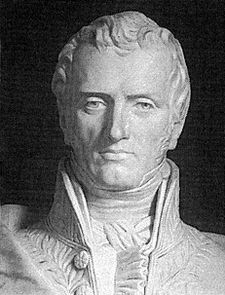Claude-Louis Navier facts for kids
Quick facts for kids
Claude-Louis Navier
|
|
|---|---|

Bust of Claude Louis Marie Henri Navier at the École Nationale des Ponts et Chaussées
|
|
| Born |
Claude Louis Marie Henri Navier
10 February 1785 |
| Died | 21 August 1836 (aged 51) |
| Nationality | French |
| Alma mater | École Nationale des Ponts et Chaussées |
| Known for | Structural analysis Navier–Stokes equations Navier–Cauchy equations |
| Scientific career | |
| Fields | Mathematical physics |
| Institutions | École Nationale des Ponts et Chaussées École polytechnique French Academy of Science |
| Academic advisors | Joseph Fourier |
Claude-Louis Navier was a clever French engineer and physicist. He was born on February 10, 1785, and passed away on August 21, 1836. He worked for the French government and was an expert in how materials and fluids behave.
He is especially famous for the Navier–Stokes equations. These important equations help us understand how liquids and gases move. He developed them with another scientist, George Gabriel Stokes.
Contents
Early Life and Education
Claude-Louis Navier was born in Dijon, France. His father died in 1793. After this, his uncle, Émiland Gauthey, looked after his education. His uncle was an engineer who worked on bridges and roads.
In 1802, Navier started studying at the École polytechnique. He then continued his studies at the École Nationale des Ponts et Chaussées in 1804. He finished his education there in 1806. Later, he took over his uncle's important role in the Corps of Bridges and Roads.
Building Bridges and Facing Challenges
Navier helped build several bridges in France. These included bridges in Choisy, Asnières, and Argenteuil. He also built a special footbridge in Paris.
In 1824, he designed a bridge called the Pont des Invalides. However, this bridge had problems and had to be taken apart. This event made people question his bridge-building skills. A government group even criticized him for relying too much on math.
Becoming a Professor
Despite this setback, Navier was recognized for his scientific work. In 1824, he became a member of the French Academy of Science.
In 1830, he started teaching at the École Nationale des Ponts et Chaussées. The next year, he also became a professor at the École polytechnique. There, he taught subjects like calculus and mechanics.
Understanding Materials and Structures
Navier made a huge impact on how we build things. In 1821, he created a mathematical way to understand how materials stretch and bend. This was called the general theory of elasticity. It helped engineers design stronger and safer buildings and bridges.
He also figured out important details about how stress works in materials. In 1826, he showed that a material's "elastic modulus" is a fixed property. This means it doesn't change based on the shape of the object. Because of these discoveries, many people see Navier as the founder of modern structural analysis. This field helps engineers make sure structures are stable.
Navier's most important contribution is the Navier–Stokes equations. He developed these in 1822. These equations are super important in fluid mechanics. They help scientists and engineers understand how liquids and gases flow. For example, they are used to design airplanes, predict weather, and even understand blood flow in the body.
A Lasting Legacy
Navier's work was so important that his name is carved on the Eiffel Tower. This shows how much he contributed to science and engineering in France.
See also
 In Spanish: Claude-Louis Henri Navier para niños
In Spanish: Claude-Louis Henri Navier para niños

